
The red-whiskered bulbul, or crested bulbul, is a passerine bird native to Asia. It is a member of the bulbul family. It is a resident frugivore found mainly in tropical Asia. It has been introduced in many tropical areas of the world where populations have established themselves. It has a loud three or four note call, feeds on fruits and small insects and perches conspicuously on trees. It is common in hill forests and urban gardens.

The yellow-eared bulbul is a species of songbird in the bulbul family of passerine birds. It is an endemic resident breeder in the highlands of Sri Lanka. The common name is also used as an alternate name for the yellow-throated bulbul.

The white-browed bulbul is a member of the bulbul family of passerine birds. It is a resident breeder in Sri Lanka and peninsular India. Largely olive coloured above with whitish underparts, it has a pale supercilium and a yellow vent. They are found in dense scrub habitats, where they skulk within vegetation and can be difficult to see although their loud and distinct burst of calls is distinctive.
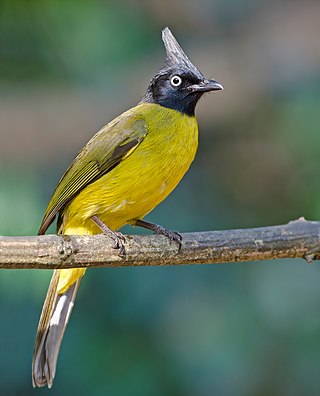
The black-crested bulbul is a member of the bulbul family of passerine birds. It is found from the Indian subcontinent to southeast Asia.

The red-vented bulbul is a member of the bulbul family of passerines. It is a resident breeder across the Indian subcontinent, including Sri Lanka extending east to Burma and parts of Bhutan and Nepal. It has been introduced in many other parts of the world and has established itself in New Zealand, Argentina, Tonga and Fiji, as well as parts of Samoa, Australia, USA and Cook Islands. It is included in the list of the world's 100 worst invasive alien species.

The common bulbul is a member of the bulbul family of passerine birds. It is found in north-eastern, northern, western and central Africa.

The graceful prinia is a small warbler. This prinia is a resident breeder in northeastern Africa and southern Asia, from Egypt and Somalia east to Saudi Arabia, where it is sometimes called streaked wren-warbler.

The yellow-throated bulbul is a species of songbird in the bulbul family of passerine birds. The species is endemic to southern peninsular India. They are found on scrub habitats on steep, rocky hills many of which are threatened by granite quarrying. It is confusable only with the white-browed bulbul with which its range overlaps but is distinctively yellow on the head and throat apart from the yellow vent. The calls of this species are very similar to that of the white-browed bulbul.
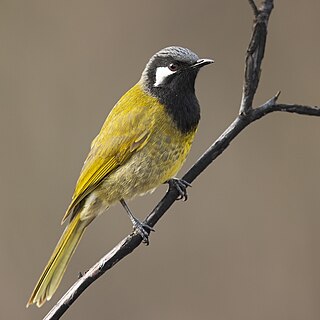
The white-eared honeyeater is a medium-sized honeyeater found in Australia. It is a member of the family Meliphagidae which has 190 recognised species with about half of them found in Australia. This makes them members of the most diverse family of birds in Australia. White-eared honeyeaters are easily identifiable by their olive-green body, black head and white ear-patch.
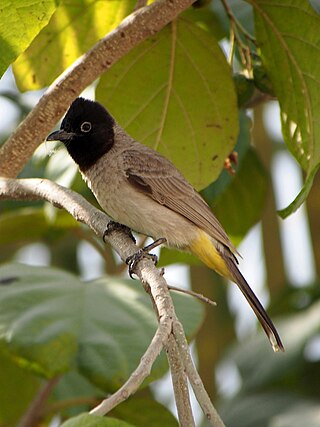
The white-spectacled bulbul is a member of the bulbul family. It is 20–25 cm (7.9–9.8 in) in length with a wingspan of 20–25 cm (7.9–9.8 in). These birds live in fruit plantations, gardens, and cities. It is the most common member of the bulbul family in Israel and Lebanon. In Turkey, it is mainly found in the coastal Mediterranean region, but its range extends from Patara/Gelemiş near Kaş in the west to Türkoğlu in the east. Breeding populations are found from Central and Southern Turkey to Western Syria, Lebanon, Israel, Western Jordan, Palestine, Sinai and western, central and southern Arabia.

The Cape bulbul is a member of the bulbul family of passerine birds. It is an endemic resident breeder in coastal bush, open forest, gardens and fynbos in western and southern South Africa. This species nests mainly in the southern spring from September to November. The nest is a thick-walled cup concealed by foliage in a small tree or shrub.
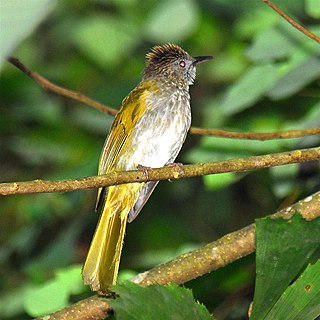
Ixos is a genus of passerine birds in the bulbul family, Pycnonotidae.
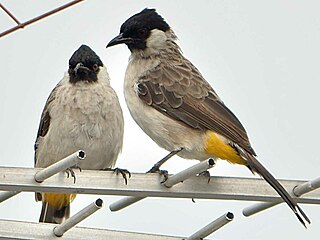
The sooty-headed bulbul is a species of songbird in the Bulbul family, Pycnonotidae. It is found in south-eastern Asia. Its natural habitat is subtropical or tropical moist lowland forests.
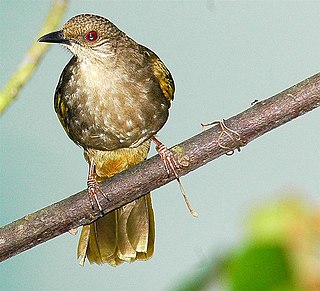
Pycnonotus is a genus of frugivorous passerine birds in the bulbul family Pycnonotidae.

The flavescent bulbul is a species of songbird in the bulbul family of passerine birds. Its name comes from flavescent, a yellowish colour. It is found in south-eastern Asia.

The Himalayan bulbul, or white-cheeked bulbul, is a species of songbird in the bulbul family found in Central and South Asia.
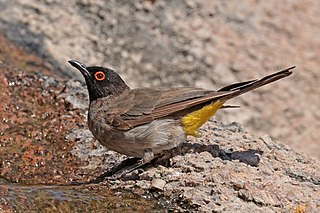
The African red-eyed bulbul or black-fronted bulbul is a species of songbird in the family Pycnonotidae. It is found in south-western Africa. Its natural habitats are dry savanna, subtropical or tropical dry shrubland, and riverine scrub. It feeds on fruit, flowers, nectar, and insects.

The flame-throated bulbul is a member of the bulbul family of passerine birds and the state bird of Goa. It is found only in the forests of the Western Ghats in southern India. Formerly included as a subspecies of Pycnonotus flaviventris it has since been elevated to the status of a full species. They are olive-backed with yellow undersides, a triangular orange-red throat and a white iris that stands out against the contrasting black head. They are usually seen foraging in groups in the forest canopy for berries and small insects. They have a call often with two or three tinkling notes that can sound similar to those produced by the red-whiskered bulbul. The species has been referred to in the past by names such as ruby-throated bulbul and black-headed bulbul, but these are ambiguous and could apply to other species such as Rubigula flaviventris and R. dispar.

The dark-capped bulbul is a member of the bulbul family of passerine birds. It is found in central, eastern and south-eastern Africa.

Vadayil Sankaran Vijayan is an Indian environmentalist, wildlife biologist, ornithologist, an admirer of naturopathy and the founding Director of the Salim Ali Centre for Ornithology and Natural History. He is currently the chairman of the Salim Ali Foundation.































